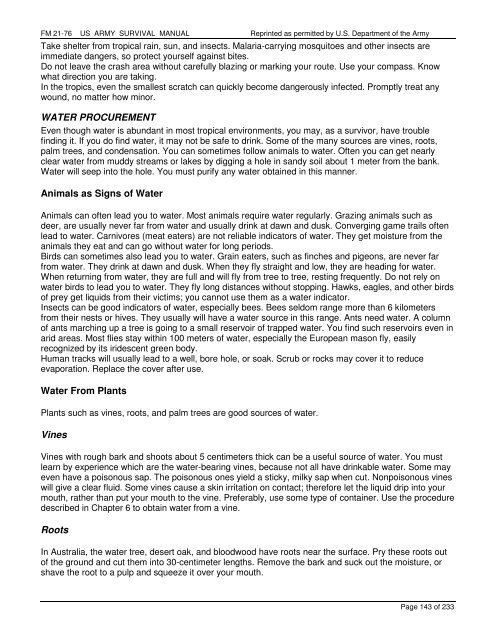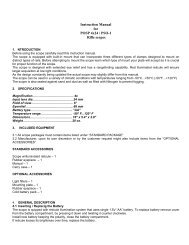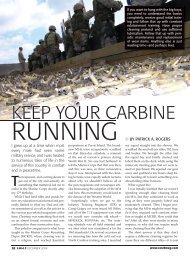FM 21-76 US ARMY SURVIVAL MANUAL - AR15.com
FM 21-76 US ARMY SURVIVAL MANUAL - AR15.com
FM 21-76 US ARMY SURVIVAL MANUAL - AR15.com
Create successful ePaper yourself
Turn your PDF publications into a flip-book with our unique Google optimized e-Paper software.
<strong>FM</strong> <strong>21</strong>-<strong>76</strong> <strong>US</strong> <strong>ARMY</strong> <strong>SURVIVAL</strong> <strong>MANUAL</strong> Reprinted as permitted by U.S. Department of the Army<br />
Take shelter from tropical rain, sun, and insects. Malaria-carrying mosquitoes and other insects are<br />
immediate dangers, so protect yourself against bites.<br />
Do not leave the crash area without carefully blazing or marking your route. Use your compass. Know<br />
what direction you are taking.<br />
In the tropics, even the smallest scratch can quickly become dangerously infected. Promptly treat any<br />
wound, no matter how minor.<br />
WATER PROCUREMENT<br />
Even though water is abundant in most tropical environments, you may, as a survivor, have trouble<br />
finding it. If you do find water, it may not be safe to drink. Some of the many sources are vines, roots,<br />
palm trees, and condensation. You can sometimes follow animals to water. Often you can get nearly<br />
clear water from muddy streams or lakes by digging a hole in sandy soil about 1 meter from the bank.<br />
Water will seep into the hole. You must purify any water obtained in this manner.<br />
Animals as Signs of Water<br />
Animals can often lead you to water. Most animals require water regularly. Grazing animals such as<br />
deer, are usually never far from water and usually drink at dawn and dusk. Converging game trails often<br />
lead to water. Carnivores (meat eaters) are not reliable indicators of water. They get moisture from the<br />
animals they eat and can go without water for long periods.<br />
Birds can sometimes also lead you to water. Grain eaters, such as finches and pigeons, are never far<br />
from water. They drink at dawn and dusk. When they fly straight and low, they are heading for water.<br />
When returning from water, they are full and will fly from tree to tree, resting frequently. Do not rely on<br />
water birds to lead you to water. They fly long distances without stopping. Hawks, eagles, and other birds<br />
of prey get liquids from their victims; you cannot use them as a water indicator.<br />
Insects can be good indicators of water, especially bees. Bees seldom range more than 6 kilometers<br />
from their nests or hives. They usually will have a water source in this range. Ants need water. A column<br />
of ants marching up a tree is going to a small reservoir of trapped water. You find such reservoirs even in<br />
arid areas. Most flies stay within 100 meters of water, especially the European mason fly, easily<br />
recognized by its iridescent green body.<br />
Human tracks will usually lead to a well, bore hole, or soak. Scrub or rocks may cover it to reduce<br />
evaporation. Replace the cover after use.<br />
Water From Plants<br />
Plants such as vines, roots, and palm trees are good sources of water.<br />
Vines<br />
Vines with rough bark and shoots about 5 centimeters thick can be a useful source of water. You must<br />
learn by experience which are the water-bearing vines, because not all have drinkable water. Some may<br />
even have a poisonous sap. The poisonous ones yield a sticky, milky sap when cut. Nonpoisonous vines<br />
will give a clear fluid. Some vines cause a skin irritation on contact; therefore let the liquid drip into your<br />
mouth, rather than put your mouth to the vine. Preferably, use some type of container. Use the procedure<br />
described in Chapter 6 to obtain water from a vine.<br />
Roots<br />
In Australia, the water tree, desert oak, and bloodwood have roots near the surface. Pry these roots out<br />
of the ground and cut them into 30-centimeter lengths. Remove the bark and suck out the moisture, or<br />
shave the root to a pulp and squeeze it over your mouth.<br />
Page 143 of 233








